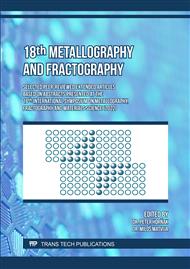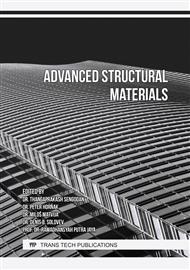[1]
T. Narushima, K. Alfirano Ueda, Co-Cr alloys as effective metallic biomaterials, In: M. Niinomi, et al. (Eds.), Advances in Metallic Biomaterials, Springer Series in Biomaterials Science and Engineering 3, Springer-Verlag, Berlin – Heidelberg, 2015, pp.157-178.
DOI: 10.1007/978-3-662-46836-4_7
Google Scholar
[2]
K. Yoda, T.A. Suyalatu, N. Nomura, Y. Tsutsumi, H. Doi, S. Kurosu, A. Chiba, Y. Igarashi, T. Hanawa, Effects of chromium and nitrogen content on the microstructures and mechanical properties of as-cast Co–Cr–Mo alloys for dental applications, Acta Biomater. 8 (2012) 2856-2862.
DOI: 10.1016/j.actbio.2012.03.024
Google Scholar
[3]
K. Yamanaka, M. Mori, A. Chiba, Mechanical properties of as-forged Ni-free Co–29Cr–6Mo alloys with ultrafine-grained microstructure, Mater. Sci. Eng. A 528 (2011) 5961-5966.
DOI: 10.1016/j.msea.2011.04.027
Google Scholar
[4]
Y. S. Al Jabbari, T. Koutsoukis, X. Barmpagadaki, S. Zinelis, Metallurgical and interfacial characterization of PFM Co–Cr dental alloys fabricated via casting, milling or selective laser melting, Dent. Mater. 30 (2014) e79-e88.
DOI: 10.1016/j.dental.2014.01.008
Google Scholar
[5]
T. Narushima, S. Mineta, K. Alfirano Ueda, π-phase and χ-phase: new precipitates in biomedical Co–Cr–Mo alloys, in: K. Sasaki (Eds.), Interface oral health science, Springer, Berlin, (2011), pp.72-80.
DOI: 10.1007/978-4-431-54070-0_12
Google Scholar
[6]
M. Kikuchi, S. Wakita, R. Tanaka, β-manganese-type phase precipitated in high chromium- high nickel austenitic steels containing nitrogen, Trans. ISIJ 13 (1973) 226-228.
DOI: 10.2355/isijinternational1966.13.226
Google Scholar
[7]
Y. Chen, Y. Li, S. Kurosu, K. Yamanaka, N. Tang, Y. Koizumi, A. Chiba, Effects of sigma phase and carbide on the wear behavior of CoCrMo alloys in Hanks' solution, Wear 310 (1-2) (2014) 51-62.
DOI: 10.1016/j.wear.2013.12.010
Google Scholar
[8]
T. Narushima, S. Mineta, Y. Kurihara, K. Ueda, Precipitates in biomedical Co-Cr alloys, JOM 65 (2013) 489-504.
DOI: 10.1007/s11837-013-0567-6
Google Scholar
[9]
K. Ueki, M. Kasamatsu, K. Ueda, Y. Koizumi, D. Wei, A. Chiba, T. Narushima, Precipitation during γ-ε phase transformation in biomedical Co-Cr-Mo alloys fabricated by electron beam melting, Metals 10 (2020) 71.
DOI: 10.3390/met10010071
Google Scholar
[10]
S. Kurosu, Y.P. Li, H. Matsumoto, A. Chiba, Grain refining technique and mechanical properties of the biomedical Co-Cr-Mo alloy, Mater. Sci. Forum 654-656 (2010) 2184-2187.
DOI: 10.4028/www.scientific.net/msf.654-656.2184
Google Scholar
[11]
S. Kurosu, H. Matsumoto, A. Chiba, Grain refinement of biomedical Co–27Cr–5Mo–0.16N alloy by reverse transformation, Mater. Lett. 64 (2010) 49-52.
DOI: 10.1016/j.matlet.2009.10.001
Google Scholar
[12]
V. I. Zurnadzhy, V.G. Efremenko, I. Petryshynets, K. Shimizu, M.N. Brykov, I.V. Kushchenko, V.V. Kudin, Mechanical properties of carbide-free lower bainite in complex-alloyed constructional steel: Effect of bainitizing treatment parameters, Kovove Mater. 58 (2020) 129-140.
DOI: 10.4149/km_2020_2_129
Google Scholar
[13]
L. Kučerová, A. Jandová, I. Zetková, Comparison of microstructure and mechanical properties of additively manufactured and conventional maraging steel, Defect Diffus. Forum 405 (2020) 133-138.
DOI: 10.4028/www.scientific.net/ddf.405.133
Google Scholar
[14]
Y. Chabak, B. Efremenko, I. Petryshynets, V. Efremenko, A.G. Lekatou, V. Zurnadzhy, I. Bogomol, V. Fedun, K. Kovaľ, T. Pastukhova, Structural and tribological assessment of biomedical 316 stainless steel subjected to pulsed-plasma surface modification: comparison of LPBF 3D printing and conventional fabrication, Materials 14 (24) (2021) 7671.
DOI: 10.3390/ma14247671
Google Scholar
[15]
Z. A. Duriagina, R.O. Tkachenko, A.M. Trostianchyn, I.A. Lemishka, A.M. Kovalchuk, V.V. Kulyk, T.M. Kovbasyuk, Determination of the best microstructure and titanium alloy powders properties using neural network. Journal of Achievements in Materials and Manufacturing Engineering, 87 (1) (2018) 25-31.
DOI: 10.5604/01.3001.0012.0736
Google Scholar
[16]
K. Dimitriadis, A.G. Lekatou, A.K. Sfikas, Μ. Roumpi, S. Tsouli, A. Galiatsatos, S. Agathopoulos, Influence of heat-treatment cycles on the microstructure, mechanical properties, and corrosion resistance of Co-Cr dental alloys fabricated by selective laser melting, J. Mater. Eng. Perform. 30 (2021) 5252-5265.
DOI: 10.1007/s11665-021-05738-9
Google Scholar
[17]
H. Choo, K.-L. Sham, J. Bohling, A. Ngo, X. Xiao, Y. Ren, P.J. Depond, M.J. Matthews, E. Garlea, Effect of laser power on defect, texture, and microstructure of a laser powder bed fusion processed 316L stainless steel, Mater. Des. 164 (2019) 107534.
DOI: 10.1016/j.matdes.2018.12.006
Google Scholar
[18]
M. Ma, Z. Wang, X. Zeng, A comparison on metallurgical behaviors of 316L stainless steel by selective laser melting and laser cladding deposition, Mater. Sci. Eng., A 685 (2017) 265-273.
DOI: 10.1016/j.msea.2016.12.112
Google Scholar
[19]
K.-S. Kim, J.-W. Hwang, K.-A. Lee, Effect of building direction on the mechanical anisotropy of biocompatible Co–Cr–Mo alloy manufactured by selective laser melting process, J. Alloys Compd. 834 (2020) 155055.
DOI: 10.1016/j.jallcom.2020.155055
Google Scholar
[20]
M. O. Vasylyev, B.M. Mordyuk, S.M. Voloshko, V.I. Zakiyev, A.P. Burmak, D.V. Pefti, Hardening of Surface Layers of Cu–39Zn–1Pb Brass at Holding and High-Frequency Impact Deformation in Liquid Nitrogen, Metallofiz. Noveishie Tekhnol. 41 (11) 2019 1499-1517.
DOI: 10.15407/mfint.41.11.1499
Google Scholar
[21]
T. Kokubo, H. Kushitani, S. Sakka, T. Kitsugi, T. Yamamuro, Solutions able to reproduce in vivo surface-structure changes in bioactive glass-ceramic A-W, J. Biomed. Mater. Res. 24 (1990) 721-734.
DOI: 10.1002/jbm.820240607
Google Scholar
[22]
Y. Chabak, V. Efremenko, M. Džupon, K. Shimizu, V. Fedun, K. Wu, B. Efremenko, I. Petryshynets, T. Pastukhova, Evaluation of the microstructure, tribological characteristics, and crack behavior of a chromium carbide coating fabricated on gray cast iron by pulsed-plasma deposition, Materials 14 (12) (2021) 3400.
DOI: 10.3390/ma14123400
Google Scholar
[23]
Y. G. Chabak, V. I. Fedun, K. Shimizu, V.G. Efremenko, V.I. Zurnadzhy, Phase-structural composition of coating obtained by pulsed plasma treatment using eroded cathode of T1 high speed steel, Problems of Atomic Science and Technology 104 (4) (2016) 100-106.
DOI: 10.46813/2019-123-167
Google Scholar
[24]
O. V. Sukhova, The effect of carbon content and cooling rate on the structure of boron-rich fe-B-C alloys, Physics and Chemistry of Solid State, 21 (2) (2020) 355-360.
DOI: 10.15330/pcss.21.2.355-360
Google Scholar



